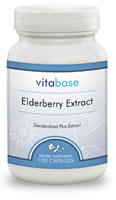| Elderberry (Elder, Sambucus) is a genus of between 5-30 species of fast-growing shrubs or small trees (two species herbaceous). The leaves are opposite, pinnate, with 5-9 leaflets (rarely 3 or 11), each leaf 5-30 cm long, the leaflets with a serrated margin. They bear large clusters of small white or cream coloured flowers in the late spring, that are followed by clusters of small red, bluish or
black (rarely yellow or white) berries. The branching stems spread about fifteen feet in the larger trees and are covered with a rough bark while the inner, larger stems, are smooth. The plant produces oval, serrated leaves, clusters of star-shaped, creamy flowers, and, eventually, blue-black juicy berries. The flowers have a strong, somewhat numbing, perfume, and are harvested in late spring, while the berries are picked in early autumn.
Elder has been used as a food and medicinal agent for thousands of years. Numerous species of elder or elderberry grow in Europe and North America. Only those with blue/black berries are medicinal. The flowers and berries are both used. Traditionally elderberry has been used in the treatment and prevention of colds, flu, sinusitis, and other conditions. The edible berries are rich in vitamin C and get their dark color form their high anthocyanin and bioflavonoid content. They are primarily used to treat flu symptoms and as an immunostimulant. Syrup is made from a decoction and taken as a prophylactic for winter colds or in combination with other expectorant herbs, such as thyme, for coughs. The infusion of the flowers can be used as a gargle for mouth ulcers and tonsillitis. The leaves are used topically to treat bruises, sprains, wounds, burns and chilblains, and may also be used as a mouthwash. Tinctures are used in combination with other herbs, such as willow, for rheumatic conditions. An oil extracted from the seeds may be massaged onto painful joints to relieve the pain of arthritis.
Acting as an antioxidant, elder may protect the body against damage from free radicals. Flavonoids, including quercetin, are believed to account for the therapeutic actions of the elderberry flowers and berries. Anthocyanins are special class of bioflavonoids, which offer powerful antioxidant protection against cellular aging. Elderberry extract reduces the damaging effects of LDL, or bad cholesterol, and serves as an antioxidant for the body. Elderberry may be useful in treating cold and flu symptoms by increasing the body's immune system response.
|
 Elderberry has long been used to support a healthy immune system. Elderberry also contains several anthocyanin flavonoids known to possess significant antioxidant properties. Elderberry Extract by Vitabase is manuafactured according to the highest pharmaceutical standards and uses only the best quality raw ingredients. Click here for more information.
Elderberry has long been used to support a healthy immune system. Elderberry also contains several anthocyanin flavonoids known to possess significant antioxidant properties. Elderberry Extract by Vitabase is manuafactured according to the highest pharmaceutical standards and uses only the best quality raw ingredients. Click here for more information.